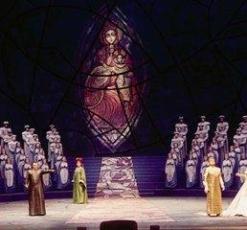Wagner – Lohengrin (Met 1967) [Bohm]
Wagner – Lohengrin (Met 1967) [Bohm]

1. Act I 2. Act II 3. Act III Lohengrin...............Sándor Kónya Elsa....................Ingrid Bjoner Ortrud..................Christa Ludwig Telramund...............Walter Berry King Heinrich...........John Macurdy Herald..................Sherrill Milnes Noble...................Dan Marek Noble...................Robert Schmorr Noble...................Gene Boucher Noble...................Ron Bottcher Conductor...............Karl Böhm Metropolitan Opera House January 21, 1967 Matinee Broadcast
Lohengrin stands as a pivotal work in the career of Richard Wagner. In terms of its structure and approach, it is usually grouped at the end of his early operas; at the same time, it demonstrates many of the ideas and techniques that would achieve full fruition in his later music dramas. Indeed, at the same time as Wagner was drafting the work, many of the ideas for his later works, such as Tristan and the Ring cycle, were already percolating (an even put to paper in some preliminary form). On the other hand, the stylistic division usually placed just after Lohengrin corresponds with a biographical one: having fled to Zurich as a political exile before the opera's Weimar premiere (in 1850, with Franz Liszt conducting), Wagner would spend the next decade articulating his aesthetic philosophies through a series of important essays. These would transform many of the ideas hinted at in Lohengrin into a full-fledged musical paradigm shift.
The story for the opera was nearly a decade in gestation. Wagner first encountered the Lohengrin myth in 1841, and within five years had outlined a scenario for an opera on the subject. The score followed a few years later, in 1848. The story is set in Antwerp, in the tenth century, where Elsa, sister to the would-be duke, Gottfried, is accused of his murder. A mysterious figure arrives to defend her and even take her as his bride, but he commands her to not inquire about his name or his unknown provenance. A count, Telramund, and his sorcerer wife, Ortrud, are Elsa's accusers, and in fact, the real culprits in Gottfried's disappearance. They lay a series of intrigues to convince Elsa to ask her mysterious hero his identity, and in so doing, bring about a sad ending to the love story but an unexpectedly happy conclusion: the return of Gottfried.
In articulating this plot through musical means, Wagner demonstrates a number of his hallmark techniques as well as his keen sense of multilayered drama. The tension between Elsa's love for her mysterious hero and her uneasy curiosity about his background is embodied by the semitone relationship of the key areas associated with each of them (A flat and A natural, respectively). Ortrud's sinister machinations cast an eerie shadow of diminished chord sonorities whenever she appears or her plans fall into place (especially effective when, in the third act, as Elsa succumbs to Ortrud's deception she also adopts a version of her theme). Likewise, the F minor sonority that consistently stands for the "forbidden question" clashes forebodingly with the C major harmonies that characterize the wedding procession at the end of Act II. These type of dramatic conceits combine with the most obvious one: as the opera centers on the utterance of the unknown name, the audience, who has been unceremoniously provided with the secret identity of the hero in the very title of the work, is in constant tension with the opera's protagonists. --- Jeremy Grimshaw, Rovi
download: yandex 4shared mediafire solidfiles zalivalka filecloudio anonfiles oboom
Zmieniony (Poniedziałek, 30 Czerwiec 2014 23:16)








